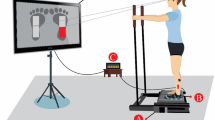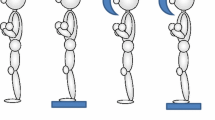Abstract
Falls are one of the main concerns of the elderly. Proper postural adjustments to maintain balance involve the activation of appropriate muscles to produce force and to relocate the center of body mass (CoM). In this study, biomechanical aspects of dynamic postural responses against forward perturbations were experimentally determined by simultaneous measurements of joint angles and EMG activations. Thirteen young and healthy volunteers took turns standing on a flat platform, and were directed to move in the forward direction by an AC servo-motor set at two different speeds (0.1 and 0.2 m/s). Joint motions were recorded, and they followed the sequence of ankle dorsiflexion, knee flexion, and then hip flexion during the later acceleration phase (AP) in order to maintain postural balance against forward perturbation. Tibialis anterior for the ankle dorsiflexion and biceps femoris for the knee flexion were activated during the second half of the AP as the primary muscles to recover balance. In addition, gastrocnemius, which was related to ankle plantarflexion, and rectus femoris, which was related to knee extension, were activated to maintain balance. Movements of the center of plantar pressure and ground reaction forces in fast-speed perturbation were significantly larger than those in slow-speed perturbation. As a result, the ankle strategy was used for slow-speed perturbation, but the mixed strategy consisting of both ankles and hip were used for fast-speed perturbation.








Similar content being viewed by others
References
Cham, R., M. S. Redfern. Lower extremity corrective reactions to slip events. J. Biomechanics 34:1439–1445, 2001. doi:10.1016/S0021-9290(01)00116-6
Ferber, R. L., R. Osterning, M. H. Woollacott, N. J. Wasielewski, and J. H. Lee. Reactive balance adjustments to unexpected perturbations during human walking. Gait Posture 16:238–248, 2002. doi:10.1016/S0966-6362(02)00010-3
Ferber, R. L., R. Osterning, M. H. Woollacott, N. J. Wasielewski, and J. H. Lee. Gait perturbation response in chronic anterior cruciate ligament deficiency and repair. Clin. Biomech. 18:132–141, 2003. doi:10.1016/S0268-0033(02)00182-1
Hsiao-Wecksler, E. T., K. Katdare, J. Matson, W. Liu, L. A. Lipsitz, and J. J. Collins. Predicting the dynamic postural control response from quiet-stance behaviour in elderly adults. J. Biomech. 36(9):1327–1333. 2003. doi:10.1016/S0021-9290(03)00153-2
Hsiao E. T., and S. N. Robinovitch. Biomechanical influences on balance recovery by stepping. J. Biomech. 32: 1099–1106. 1999. doi:10.1016/S0021-9290(99)00104-9
Hsiao-Wecksler, E. T., and S. N. Robinovitch. The effect of step length on young and elderly women’s ability to recover balance. Clin. Biomech. 22(5):574–580. 2007. doi:10.1016/j.clinbiomech.2007.01.013
Hodges, P. W., B. H. Bui. A comparison of computer-based methods for the determination of onset of muscle contraction using electromyography. Eletroencephalogr. Clin. Neurophysiol. 101:511-519. 1996.
Horak, F. B. Clinical assessment of balance disorder, Gait Posture 6:76-84, 1997. doi:10.1016/S0966-6362(97)00018-0
Hughes, M. A., M. L. Schenkman, J. M. Chandler, and S. A. Studenski. Postural responses to platform perturbation: kinematics and electromyography. Clin. Biomech. 10:318–322, 1995. doi:10.1016/0268-0033(94)00001-N
Kamen, G., C. Patten, C. Duke, and S. Silson. An Accelerometry-Based system for the Assessment of Balance and Postural Sway. J. Gerontol. 44:40-45, 1998. doi:10.1159/000021981
Karlsson, A., G. Frykberg. Correlations between force plate measures for assessment of balance. Clin. Biomech. 15:365-369, 2000. doi:10.1016/S0268-0033(99)00096-0
Kleissen, R. F. M., J. H. Buurke, J. Harlaar, and G. Zilvold. Electromyography in the biomechanical analysis of human movement and its clinical application. Gait and Posture 8:143-158, 1998. doi:10.1016/S0966-6362(98)00025-3
Mayagoitia, R. E., J. C. Lotters, P. H. Veltink, and H. Hermens. Standing balance evaluation using a triaxial accelerometer. Gait Posture 6:55–59. 2002. doi:10.1016/S0966-6362(01)00199-0
Nashner, L., G. McCollum. The organization of human postural movements: a formal basis and experimental synthesis. Behav. Brain Sci. 8:135–172, 1985.
Nilssen, R. M. A new method for evaluating motor control in gait under real-life environmental conditions. Part 2: Gait analysis. Clinical Biomechanics 13:328-335, 1998. doi:10.1016/S0268-0033(98)00090-4
Nilssen, R. M., J. L. Helbostad. Trunk accelerometry as a measure of balance control during quiet standing. Gait and Posture 16:60-68. 2002. doi:10.1016/S0966-6362(01)00200-4
Onell, A. The vertical ground reaction force for analysis of balance. Gait Posture 12:7-13, 2002. doi:10.1016/S0966-6362(00)00053-9
Runge, C. F., C. L. Shupert, F. B. Horak, and F. E. Zajac. Ankle and hip postural strategies defined by joint torques. Gait and Posture 10:161-170, 1999. doi:10.1016/S0966-6362(99)00032-6
Staude, G., W. Wolf. Objective motor response onset detection in surface myoelectric signals. Medical Eng. & Physics 21:449-467. 1999. doi:10.1016/S1350-4533(99)00067-3
Winter, D. A. Anatomy Biomechanics and Control of Balance During Standing and Walking. Waterloo: Biomechanics Inc., 157 pp, 1990
Yi, J. B., S. J. Kang, and Y. H. Kim. Characteristics of Vertical Acceleration at Center of Mass of the Body in Normal Gait. KAUTPT 9:39-46. 2002.
You, J. Y., Y. L. Chou, C. J. Lin, and F. C. Su. Effect of slip on movement of body center of mass relative to base of support, Clin. Biomech. 16:167-173, 2001. doi:10.1016/S0268-0033(00)00076-0
Acknowledgments
This research project was supported by the Sports Promotion Fund of Seoul Olympic Sports Promotion Foundation from Ministry of Culture, Sports and Tourism and also was financially supported by the Ministry of Education, Science Technology (MEST) and Korea Industrial Technology Foundation (KOTEF) through the Human Resource Training Project for Regional Innovation.
Author information
Authors and Affiliations
Corresponding author
Rights and permissions
About this article
Cite this article
Hwang, S., Tae, K., Sohn, R. et al. The Balance Recovery Mechanisms Against Unexpected Forward Perturbation. Ann Biomed Eng 37, 1629–1637 (2009). https://doi.org/10.1007/s10439-009-9717-y
Received:
Accepted:
Published:
Issue Date:
DOI: https://doi.org/10.1007/s10439-009-9717-y




